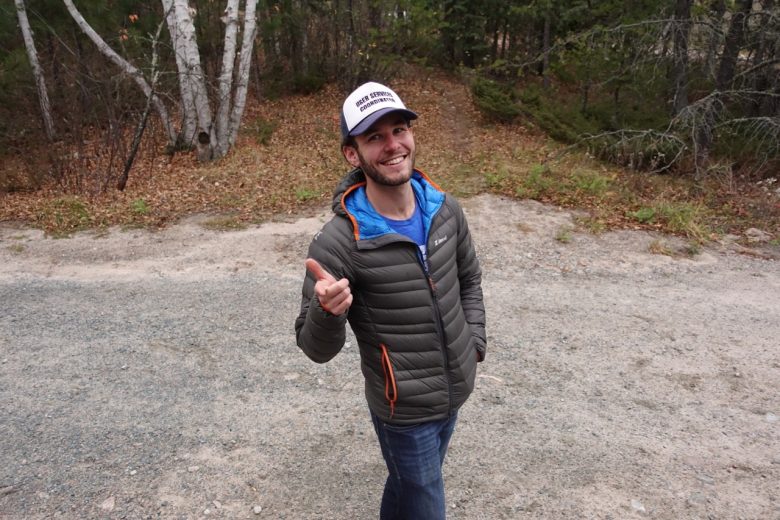News November 6, 2017
7,000 Days of IISD-ELA. In One Calendar Year…?
By Roger Mollot, Operations Manager
Next year, IISD Experimental Lakes Area turns 50. As we head towards that significant milestone, more people than ever are coming out to stay, research and explore the site. In fact, we counted 7,000 “usage days” this year alone. Have you ever wondered what goes on behind the scenes—how our team can make this happen? Want to know what it is like to come visit the station? Roger Mollot, our Operations Manager, explains all…
7,000 Days of IISD Experimental Lakes Area
Each day that an individual is on site at the IISD-ELA facility counts towards a grand total of site usage days. Whoever you are—whether staff, student, contractor or on a site tour—your presence counts towards that total.
We use these numbers as an indicator of how the facility is being used throughout the year. For 2017, site usage numbers show a significant rise in the number of people present at the facility. While last year we recorded almost 6,000 usage days, we have registered over 7,000 this year, and the ice has not yet formed on the lakes!
This is a sign that more people are coming out to the world’s freshwater laboratory for research, education and outreach activities. Greater usage numbers do present some logistical challenges, but these are good problems to have.

We operate a fleet of trucks and vans, ATV and snowmobiles, canoes and boats. All of this equipment must be maintained and monitored to ensure the safety of the operator during those 7000 usage days.
Taking You Behind the Scenes
While IISD-ELA is internationally recognized for the unique opportunities it offers to conduct whole-ecosystem research, less known is the considerable effort behind the scenes to make it all happen.
First up, we need to take care of facility maintenance and upgrades to infrastructure and equipment. The field station is at the end of a 30 km gravel road that winds its way through the boreal forest. For people and supplies to safely arrive at the facility, the road needs to be maintained to prevent potholes, plowed of snow and ice, and brushed to keep the forest at bay; ditching and culverts need to be repaired or unplugged from the incessant work of beavers; fallen trees are removed from trails; and docks and boardwalks need to be repaired.
7,000 days is a lot of activity to pack into a single calendar year. And it represents a lot of pancakes, pizza and palak paneer (not in that order).
We operate a fleet of trucks and vans, ATVs and snowmobiles, canoes and boats. All of this equipment must be maintained and monitored to ensure the safety of the operators during those 7,000 usage days.
This year our facilities manager, John Neall, our new assistant facilities manager, Clayton Lund, and our operations assistant, Cody Jackson, were busy keeping ahead of all these things to enable everyone safe access to the lakes in order to conduct their research.
What Happens After Hours
And where do 7,000 usage days lay their heads down at night to sleep? The facility has three residences where the majority of our visitors stay, along with five cabins and a trailer. We can comfortably accommodate at least 55 people. Coordinating where people stay, monitoring the use and cleanliness of buildings, organizing shuttle vans to move people on- and off-site, and bringing in food and maintenance supplies falls on the capable shoulders of our user services coordinator, Stephen Paterson.

A massive thumbs up for all our staff who keep IISD Experimental Lakes Area going behind the scenes.
Equally important to the safe arrival and comfortable stay for all persons on-site is the food that fuels the research. Working in the field requires carrying heavy packs down portage trails in all kinds of weather. A good meal sets the tone for the day, and indeed it can influence the morale of the entire field station. 7,000 usage days represents a lot of pancakes, pizza and palak paneer (not in that order).
Our head chef, Frank McCann, and sous chef, Jesse Coelho, have helped raise the morale of the entire crew and complement our appetite for scientific research. If there were a gastronomic equivalent of the Stockholm Water Prize (awarded to retired ELA scientist David Schindler in 1991) this culinary duo have earned a nomination.
The open water season is drawing to a close as our site usage numbers climb for 2017, a record-setting year for IISD-ELA as operator of the facility. With new research projects set to launch in the spring, the operations team will take the winter months to prepare for the arrival of new researchers, students and associated equipment in need of periodic maintenance.
7,000 days is a lot of activity to pack into a single calendar year.